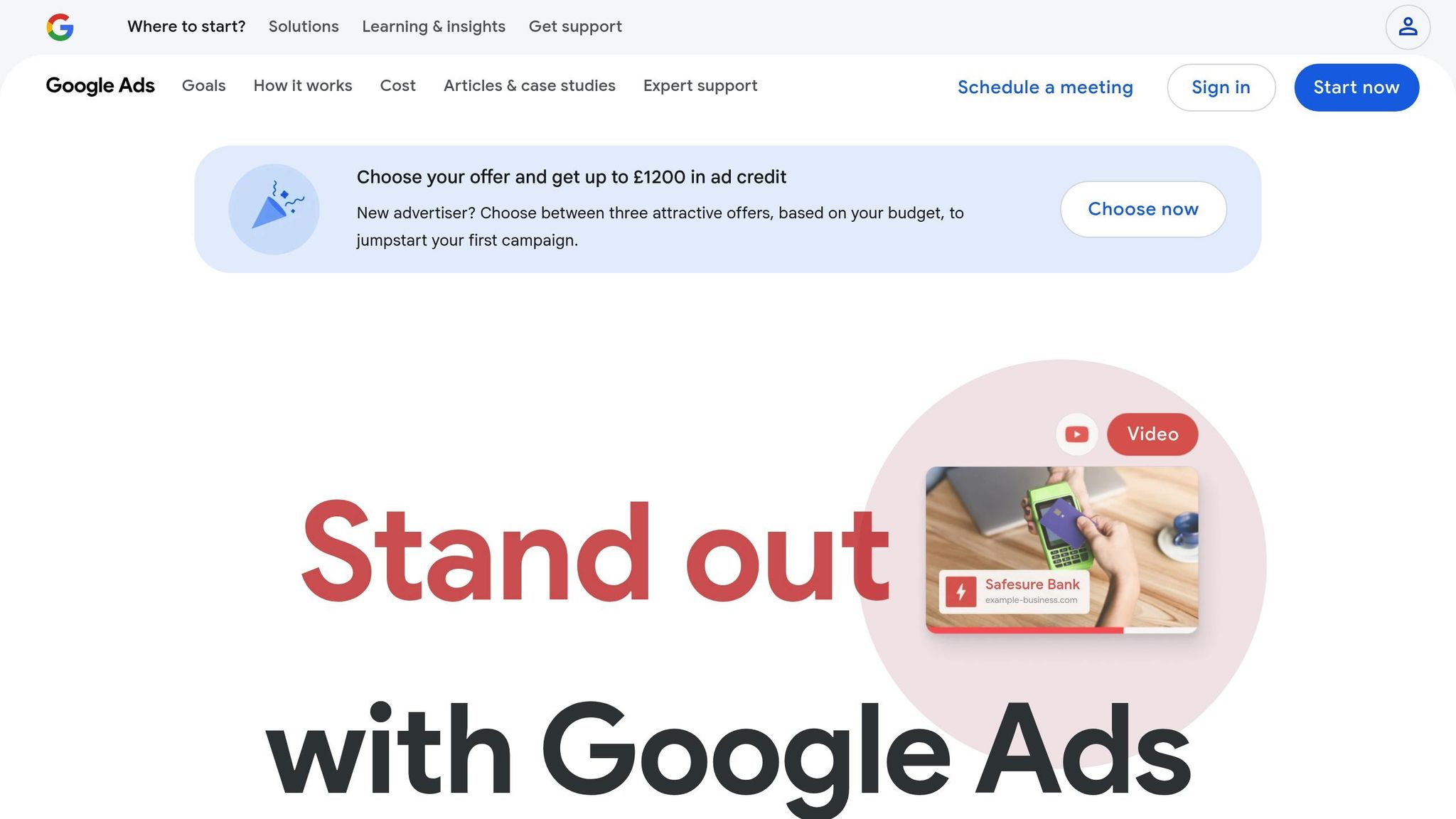How Auction Insights Helps Outrank Competitors
Google Ads‘ Auction Insights is a tool that compares your ad performance with competitors bidding on the same keywords. It helps you understand where your campaigns stand, revealing metrics like Impression Share, Position Above Rate, and Outranking Share. These metrics show how often your ads appear, how frequently competitors rank above you, and where you outperform them.
Key takeaways:
- Impression Share: Percentage of eligible impressions your ads receive.
- Position Above Rate: How often competitors rank higher than you.
- Outranking Share: How often your ads rank above competitors or appear when theirs don’t.
- Top of Page Rate: Frequency of your ads appearing at the top of search results.
Use this data to:
- Adjust bids for better ad placements.
- Refine keyword strategies to target less competitive terms.
- Monitor trends to identify high-bidding rivals or market gaps.
Regular analysis can help optimise campaigns, improve visibility, and reduce wasted spend. By leveraging Auction Insights effectively, you can make informed decisions to stay ahead in the competitive PPC landscape.
Google Ads Auction Insights Report: Everything You Need to Know

Key Metrics in Auction Insights Explained
Understanding metrics like Impression Share, Position Above Rate, Top of Page Rate, and Outranking Share gives you a detailed view of how your ads measure up against the competition.
Impression Share
Impression Share is a cornerstone metric for evaluating your competitive position. It represents the percentage of impressions your ads received compared to the total they were eligible for. Eligibility is influenced by factors like your targeting settings, ad approval status, and Quality Scores.
In the Auction Insights report, this metric also reveals how your Impression Share stacks up against other advertisers in auctions where both of you were eligible to appear. However, it’s essential to go beyond this number – high visibility doesn’t always translate to positive returns. Analysing your return on investment ensures you’re not overspending just to be seen. On the flip side, a lower Impression Share compared to competitors could signal the need to tweak your bids or improve ad quality for better visibility.
It’s worth noting that the report won’t display data if your Impression Share falls below 10%.
Once you’ve assessed your Impression Share, it’s time to examine how your ad positions compare to others.
Position Above Rate and Top of Page Rate
Position Above Rate measures how often a competitor’s ad outranks yours when both appear in the same auction. For instance, if a competitor has a Position Above Rate of 5%, their ad appeared above yours 5 out of 100 times when both were shown. This metric can directly influence your campaign’s success – being consistently outranked might mean missed clicks and opportunities.
Top of Page Rate, on the other hand, tracks how often your ad appears at the top of the page, above organic search results. For example, a Top of Page Rate of 20% indicates that your ad appeared in this premium spot 20 times out of 100 impressions. These top positions often attract higher click-through rates and greater visibility.
"Competitor analysis provides a visual of the PPC landscape before you enter it. It helps you understand how your strategy is working and where you may have gaps. Looking at the data on an ongoing basis provides information on position, budgets, copy, and opportunity." – Alyssa Galik, Lead Strategist and PPC expert
These metrics help you evaluate whether your bidding strategy is competitive enough to secure prime ad placements. They also set the stage for analysing how often your ads outperform competitors, which is where Outranking Share comes in.
Outranking Share
Outranking Share reveals how often your ad ranks higher than a competitor’s or appears when theirs do not. A high Outranking Share indicates strong performance against the competition, while a lower share might suggest it’s time to adjust your strategy.
How to Analyse Competitor Data
Auction Insights is a powerful tool for decoding competitor behaviour and identifying strategic opportunities. Interestingly, your top competitors in search may not always be the ones you expect. By leveraging these insights, you can better understand potential threats and opportunities within your PPC strategy.
"Auction Insights in Google Ads and Microsoft Advertising offers a ready-made solution for viewing key data about competitor ads where they’re bidding against the same queries as you."
– Tim Jensen, Sr. Search Engine Marketing Specialist at M&T Bank
Identifying High-Bidding Competitors
To spot aggressive competitors, focus on metrics like impression share and overlap rate. Competitors with a consistently high presence in these areas are likely engaging in aggressive bidding strategies.
Pay attention to emerging brands with rising impression shares, as they may be testing new markets or launching expansion campaigns. These shifts could highlight both potential threats and areas for growth.
Another key metric is the Position Above Rate, which reveals how often a competitor’s ad appears above yours. If competitors maintain a high position above rate despite moderate impression shares, they may be strategically targeting high-value keywords – a sign of advanced campaign tactics.
Tracking Competitor Activity Over Time
Regular monitoring is crucial. Monthly reports can help you identify bidding trends and seasonal strategies. For example, a declining impression share might suggest that competitors are either increasing bids or improving their ad quality. Conversely, an increasing impression share could indicate growing competitiveness.
Tracking Overlap Rate trends can also reveal when competition intensifies or when rivals shift their focus. For more detailed insights, consider monitoring metrics daily or even hourly to spot peak activity periods.
"Trends can provide important insights, so don’t forget to look at how these metrics change over time. If your Outranking Share is decreasing, it might be a sign that competitors are stepping up their game."
– Michael Uribe
Additionally, analysing year-over-year performance and accounting for seasonal trends can help you fine-tune your strategy for high-conversion periods. These insights can also uncover untapped opportunities where competitors are underperforming.
Finding Market Gaps
The combination of Outranking Share and impression share can help you identify competitors who are visible but underperforming. For instance, a competitor with high visibility but low outranking share might struggle with ad relevance or landing page effectiveness.
Keep an eye out for areas where competitors have a low impression share. These gaps could be opportunities for you to capture additional market share. If established competitors are scaling back activity in specific keyword areas, it’s worth investigating whether demand has shifted or if they’ve reallocated their budgets.
For example, competitive insights can reveal when rivals reduce their budgets. This opens up opportunities for you to gain traction and increase your market share. Similarly, refining your strategy by identifying costly search terms, boosting investment in non-brand keywords, and pausing underperforming terms can lead to significant improvements in impression share and order volume, along with meaningful cost savings.
Finally, remember that the competitors listed in Google’s Auction Insights may differ from those in Microsoft’s. Microsoft’s platform often features fewer active brands, which could present opportunities to dominate less competitive spaces.
That said, Auction Insights only provides a snapshot of competitor activity for overlapping search terms. Use this data as a starting point for deeper competitive analysis rather than relying on it for a complete view of your rivals’ PPC strategies.
sbb-itb-dcae4ad
Tactics to Outrank Your Competitors
Once you’ve analysed your competitors’ data, the next step is turning those insights into actionable strategies that give you an edge. The goal isn’t just to outspend competitors but to make smarter decisions. As Google explains, "The auction insights report lets you compare your performance with other advertisers who are participating in the same auctions that you are. This information can help you make strategic decisions about bidding and budgeting by showing you where you’re succeeding and where you may be missing opportunities for improved performance."
Refining Your Keyword Strategy
Your keyword approach should adapt based on what competitors are doing. Start by examining overlap rates to pinpoint areas where you’re competing directly for the same keywords. This can help you identify opportunities to focus on less competitive, niche keywords that may offer higher conversion potential.
If you notice competitors targeting irrelevant keywords, you can save money by adding those terms as negative keywords to your campaigns. On the other hand, when competitors consistently outrank you for specific keywords, evaluate whether those terms align with your goals. If they do, consider adjusting your bids to stay competitive.
Setting Better Bids and Budgets
Smart bidding doesn’t mean spending more – it means spending wisely. Focus on increasing bids for high-conversion keywords where competitors are outperforming you. Automated bidding strategies, like Target ROAS or Target Impression Share, can also help you systematically improve your rankings without micromanaging every bid.
Reassess your budget allocation by shifting funds from underperforming campaigns to areas where you can achieve better results. For example, you might reduce spending on low-performing keywords and instead invest in targeting extended keywords or even bidding on competitor brand names, if allowed by Google’s policies. Additionally, use bid modifiers to refine your targeting based on factors like demographics, location, or device usage.
Creating Better Ads and Landing Pages
Outperforming competitors isn’t just about bidding – it’s about delivering a superior ad experience. Start by manually searching your target keywords to see what competitors are doing. Tools like the Google Ads Transparency Center can help you analyse their messaging and keyword focus.
Craft ad copy that highlights your unique benefits to stand out. At the same time, optimise your landing pages to ensure they match user intent and drive engagement. For high-competition keywords where performance is lagging, refining your landing pages can make a big difference in boosting conversion rates.
Use Auction Insights data alongside A/B testing to continually improve your ads, keyword strategy, and landing pages. Remember, success isn’t just about spending more – it’s about making smarter, data-driven choices. Regularly reviewing Auction Insights keeps you prepared for shifts in the market.
Next, discover how working with PPC specialists can take your performance to the next level.
Working with PPC Specialists for Better Results
Auction Insights strategies can be incredibly effective, but interpreting the data often requires a deep understanding of campaign dynamics. That’s where PPC specialists come in. Their expertise allows them to transform complex metrics into actionable strategies that can significantly impact your business. Let’s explore how their analysis can turn raw data into meaningful results.
Getting Expert Data Analysis
Professional PPC analysts dive deep into Auction Insights, blending this data with overall campaign performance to craft strategies that align with your business goals. For example, they can keep an eye on brands gaining traction in impression share, analyse historical patterns to identify seasonal trends, and respond to current events. They also compare Auction Insights data across platforms like Google Ads and Microsoft Advertising, uncovering new competitors and cross-channel opportunities.
Specialists use this data to make informed adjustments, such as fine-tuning bids for high-value keywords based on impression share and outranking share. Joe Martinez, Co-Founder of Paid Media Pros, highlights the importance of this approach:
"Take that list of competitors and use a tool like SEMRush or SpyFu, and see which other keywords they’re bidding on. I like to do this if I’m seeing the same competitor showing up in the majority or all of my ad groups. Maybe they found some other keywords that I haven’t thought of yet."
By integrating Auction Insights with other reports, like the Search Terms report, experts ensure that competitive insights are woven into every aspect of your campaign. This comprehensive approach means every decision is backed by data, from keyword selection to ad placement.
Free PPC Audit and Detailed Reporting
In addition to data analysis, structured audits and detailed reporting play a crucial role in refining your campaigns. A thorough PPC audit lays the groundwork for implementing advanced Auction Insights strategies. The PPC Team offers a free audit that systematically evaluates your paid search campaigns. This process identifies wasted ad spend, highlights opportunities for optimisation, and provides a clear roadmap for refining keywords, adjusting bids, and improving ad placements.
Audits also assess audience targeting, ensuring your efforts align with broader business objectives. Detailed reporting complements this by offering real-time insights into campaign performance. As PPC Geeks point out:
"The ability to measure results in real-time empowers businesses to make informed decisions, leading to improved advertising strategies and enhanced growth."
Regular reporting ensures your campaigns stay updated with the latest strategies, tools, and trends. Metrics like click-through rates, conversion rates, and cost per acquisition are tracked alongside competitive data, giving you a comprehensive view of your Auction Insights performance.
The complexity of today’s competitive landscape makes professional PPC management invaluable. The PPC Team specialises in creating tailored strategies that merge competitor analysis with conversion tracking and business reporting. By working with specialists, you can shift from a reactive approach to a proactive one, ensuring your campaigns consistently drive measurable growth and maintain a competitive edge.
Conclusion: Putting Auction Insights to Work
Auction Insights offers clear, actionable data that shows how your ads stack up against competitors. By highlighting metrics like impression share, overlap rate, and outranking share, it gives you the tools to adjust bids, fine-tune keyword strategies, and spot gaps in the market where competitors are less active. These insights aren’t just numbers – they’re a way to make immediate changes that strengthen your market position.
For example, if a competitor with a lower impression share consistently achieves higher ad positions, it’s a sign they might be using aggressive bidding tactics or delivering higher-quality ads. This kind of information can help you rethink your approach. The PPC Team specialises in analysing these metrics, uncovering trends, and turning data into strategies. Their services, like in-depth competitor analysis, tailored recommendations, free PPC audits, and detailed reporting, are designed to help businesses get the most out of their PPC campaigns and outperform competitors.
To put these insights to work, start by optimising your bids, refining your keyword focus, and experimenting with creative strategies. Regularly reviewing Auction Insights data ensures your campaigns stay competitive and adapt to changes in the market. With this tool as your foundation – and expert guidance to interpret the data – you can move from simply reacting to challenges to building proactive strategies that drive consistent, measurable growth.
FAQs
How can I use the Impression Share metric to improve my PPC campaign performance?
To get the best results from the Impression Share metric, work on boosting your ad visibility by tweaking your bids, budget, and Quality Score. Look at keywords that aren’t performing well and make adjustments to improve their rankings, while directing more budget towards those that are delivering strong results.
Impression Share data can also help you identify opportunities where your ads could show up more often or in better positions. Refine your targeting strategies – like adjusting ad schedules or focusing on specific devices – to maximise your visibility. By applying these insights, you can fine-tune your campaigns and stay ahead of your competitors.
How can I improve my ad ranking if competitors are consistently outranking me?
If your competitors’ ads keep outranking yours, it’s time to focus on two key areas: ad relevance and Quality Score. Make sure your keywords align closely with what users are searching for, and refine your ad copy to resonate with your audience. Engaging, targeted messaging can make all the difference.
Don’t stop there – take a closer look at your landing pages. A seamless user experience and relevant content can significantly boost performance. Incorporate ad extensions to add extra details, making your ads more informative and enticing. Finally, adjust your bids wisely to stay competitive without overspending. With these strategies in place, you’ll be in a stronger position to climb the rankings and outpace your competition.
How can Auction Insights help me find and take advantage of areas where competitors are less active?
Auction Insights offers a detailed look at your competitors’ behaviour in PPC campaigns, revealing where they might be less active or bidding with less intensity. By digging into this data, you can uncover opportunities to step into these gaps with well-planned bids and customised ad strategies.
This method helps you allocate your budget more effectively, concentrating on areas with less competition. The result? Improved visibility and potentially better outcomes, all without the need to stretch your spending. Using Auction Insights wisely can be a game-changer for your PPC strategy.

